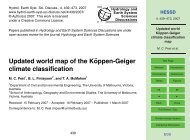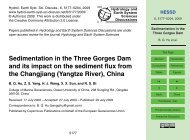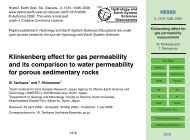In-situ evaluation of internal drainage in layered soils (Tukulu - hessd
In-situ evaluation of internal drainage in layered soils (Tukulu - hessd
In-situ evaluation of internal drainage in layered soils (Tukulu - hessd
Create successful ePaper yourself
Turn your PDF publications into a flip-book with our unique Google optimized e-Paper software.
5<br />
10<br />
15<br />
20<br />
25<br />
5<br />
10<br />
15<br />
20<br />
25<br />
C horizon was on the <strong>in</strong>terior. The A-horizon showed a K -θ coefficient rang<strong>in</strong>g<br />
from 23.5 to 0.0002 mm h −1 for a soil water content <strong>of</strong> 0.34 to 0.29 mm mm −1 .<br />
The K -θ coefficient for the B horizon ranged from 42.8 to 0.0007 mm h −1 with<br />
a SWC rang<strong>in</strong>g from 0.344 to 0.299 mm mm −1 . For the C horizon the K -θ coef-<br />
ficient ranged from 76.5 to 0.001 mm h −1 with a soil water content rang<strong>in</strong>g from<br />
0.33 to 0.22 mm mm −1 . The K -θ relationships from the three horizons atta<strong>in</strong>ed<br />
a goodness <strong>of</strong> fit <strong>of</strong> not less than 0.89. Failure <strong>of</strong> the Bartletts test <strong>of</strong> homogeneity<br />
was re-affirmed by the significant differences found by both the pooled regression<br />
coefficient F -test and student’s t-test analyses. A different result was captured by<br />
the student’s t-test when a comparison between the A and B horizon was made.<br />
3.4 θ-T relationship <strong>of</strong> soil horizons<br />
The θ-T relationship for the <strong>Tukulu</strong>, Sepane and Swartland soil types for the first 200 h<br />
<strong>of</strong> <strong><strong>in</strong>ternal</strong> <strong>dra<strong>in</strong>age</strong> are presented <strong>in</strong> Fig. 6. The power regression functions for the A,<br />
B and C horizons for these <strong>soils</strong> are presented <strong>in</strong> Table 7 and the student’s t-test for<br />
the comparison <strong>of</strong> regression coefficients between horizons θ-T functions presented<br />
<strong>in</strong> Table 8. The presence <strong>of</strong> restrictive horizon layers <strong>in</strong>fluenced the manner <strong>in</strong> which<br />
these <strong>soils</strong> dra<strong>in</strong>ed.<br />
– <strong>Tukulu</strong>: the θ-T relationship for this soil <strong>in</strong>dicated an <strong>in</strong>crease <strong>in</strong> SWC with depth<br />
although each layer cont<strong>in</strong>ued to dra<strong>in</strong> <strong>in</strong>stantaneously. The amount <strong>of</strong> water that<br />
dra<strong>in</strong>ed away with<strong>in</strong> the first 3 h was 5.1 mm from the orthic A and 2.4 mm from the<br />
neocutanic B horizon from an <strong>in</strong>itial field saturation <strong>of</strong> 0.328 and 0.325 mm mm −1 ,<br />
respectively. At field saturation <strong>of</strong> 0.324 mm mm −1 the C horizon lost 1.5 mm for<br />
the same period. At the end <strong>of</strong> the 200 h <strong>dra<strong>in</strong>age</strong> period the A, B and C horizons<br />
dra<strong>in</strong>ed away water amount<strong>in</strong>g to 8.1, 6.2 and 3.1 mm, respectively. The <strong>dra<strong>in</strong>age</strong><br />
flux <strong>of</strong> 0.001 mm h −1 equivalent to DUL was realised after 660 h (28 days) after<br />
<strong>dra<strong>in</strong>age</strong> for the A and B horizons while from the C horizon DUL was realised<br />
after 390 h (16 days). Correspond<strong>in</strong>g SWC was 0.30 mm mm −1 for the A and B<br />
9811<br />
horizons and 0.31 mm mm −1 for the C horizon. The student’s t-test also confirmed<br />
the similarities observed between the upper horizons.<br />
– Sepane: from the θ-T relationship <strong>of</strong> the three horizon layers soil water content<br />
<strong>in</strong>creased with depth while <strong>dra<strong>in</strong>age</strong> rates decreased. The amount <strong>of</strong> water that<br />
dra<strong>in</strong>ed away from field saturation <strong>of</strong> 0.326, 0.332 and 0.338 mm mm −1 with<strong>in</strong> the<br />
first 3 h was 4.7, 2.8 and 2 mm for the respective A, B and C horizons. At the end<br />
<strong>of</strong> 200 h the layers dra<strong>in</strong>ed a respective water content amount<strong>in</strong>g to 8.5, 5.4, and<br />
3 mm. The <strong>dra<strong>in</strong>age</strong> flux <strong>of</strong> 0.001 mm h −1 was atta<strong>in</strong>ed after 660, 480 (20 days)<br />
and 300 (13 days) hours from saturation at SWC <strong>of</strong> 29.4, 31.7 and 32.3 mm mm −1 ,<br />
for the A, B and C horizons, respectively. The student’s t-test also confirmed the<br />
comparable differences found between these soil horizons.<br />
– Swartland: soil water content was concentrated on the upper soil horizons with<br />
the B horizon assum<strong>in</strong>g a higher water content regime throughout the <strong>dra<strong>in</strong>age</strong><br />
period. The amount <strong>of</strong> water that dra<strong>in</strong>ed away with<strong>in</strong> 3 h was 4.6 mm from the<br />
A horizon, 3.76 mm from the B horizon and 6 mm from the C horizon. After<br />
200 h <strong>of</strong> <strong>dra<strong>in</strong>age</strong> 8.6 mm, 7.5 mm and 26 mm dra<strong>in</strong>ed from an <strong>in</strong>itial field saturation<br />
<strong>of</strong> 0.34, 0.344 and 0.33 mm mm −1 for the A, B and C horizons, respectively.<br />
A <strong>dra<strong>in</strong>age</strong> flux <strong>of</strong> 0.001 mm h −1 was achieved after 672 (28 days) hours from the<br />
A and B horizons with a respective SWC <strong>of</strong> 0.29 and 0.30 mm mm −1 . Although the<br />
student’s t-test found these two horizons to be comparable the pooled variation<br />
was the least among the pairs.<br />
3.5 Total <strong>dra<strong>in</strong>age</strong> and flux rates<br />
Total <strong>dra<strong>in</strong>age</strong> and flux rates from the <strong><strong>in</strong>ternal</strong> <strong>dra<strong>in</strong>age</strong> trial were summarized <strong>in</strong> Table 9<br />
and Fig. 7, respectively. The respective <strong>dra<strong>in</strong>age</strong> amounts from the three soil types<br />
showed a decrease with depth with the exception <strong>in</strong> the Swartland. <strong>In</strong> all the <strong>soils</strong> the<br />
amount that dra<strong>in</strong>ed away from approached negligible levels (DUL) at <strong>dra<strong>in</strong>age</strong> flux<br />
9812<br />
Discussion Paper | Discussion Paper | Discussion Paper | Discussion Paper |<br />
Discussion Paper | Discussion Paper | Discussion Paper | Discussion Paper |







